When most people talk about Thailand, they rather naively think only of Bangkok, transit to what seems like half of the world’s international flights and popular shopping destination. The second thing that comes into mind is the fun and frolic on the beaches of Thailand, in getaway destinations like Pattaya, Ko Samui and Phuket. Deep blue waters, golden sands and the year round warm, tropical weather of the nation are huge pulls for millions of tourists each year. However, these initial assumptions about Thailand would make for a very clichéd touristy trip, something that one can avoid easily.
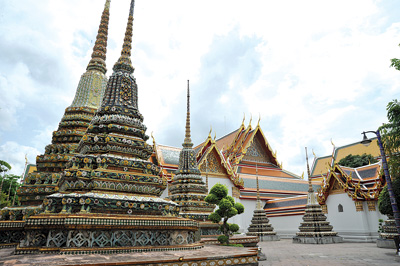 For most tourists a holiday in Nepal is synonymous to trekking in and around Nepal’s several snowcapped 8000m peaks. They shouldn’t be blamed for this, trekking is an amazing, rejuvenating activity - specially in Nepal – that helps one reconnect with Nature. It helps that at every turn on the trail, you run into (clichéd but still very true) hospitable and interesting Nepali people besides being bombarded with fascinating festivals punctuating the year, a treasure trove of traditional crafts and delicious local cuisine. Still, something feels amiss when all you have on your itinerary is trekking.
For most tourists a holiday in Nepal is synonymous to trekking in and around Nepal’s several snowcapped 8000m peaks. They shouldn’t be blamed for this, trekking is an amazing, rejuvenating activity - specially in Nepal – that helps one reconnect with Nature. It helps that at every turn on the trail, you run into (clichéd but still very true) hospitable and interesting Nepali people besides being bombarded with fascinating festivals punctuating the year, a treasure trove of traditional crafts and delicious local cuisine. Still, something feels amiss when all you have on your itinerary is trekking.
This is why
Buddhism spreads from its origins in Northern India, where the Buddha was enlightened to places like Sri Lanka, Thailand, Burma and other South East Asian countries. It also spread north into Nepal, besides Sikkim, Bhutan, Central Asia, China, Korea and Japan.
However, Buddhism all but died out in India after the Muslim incursions of the 11th Century CE. The spread of communism has also virtually obliterated Buddhism from countries such as China and Vietnam where it was once strongly established. Nowadays, however, Buddhism is attracting an increasing following in Europe and the Americas. In Asia, it is thriving in countries like Sri Lanka, Burma, Nepal, Thailand, Korea and Japan.
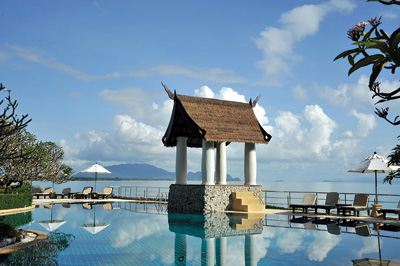 A country where 95% of the population practice Buddhism of the Theravada school, Thailand for the interested, besides being a ‘holiday’ destination, is also a land of rich culture, traditions, arts and architecture, most of which has been preserved and guarded for several centuries. Buddhism spread in Nepal around the same time and the Vajrayana sect of Buddhism is widely practiced in the country. Nepal’s own history of art, craft, culture and architecture is as rich, although it’s preservation is an area that is only just gathering interest and pace. Where Nepal lags behind and can learn from Thailand is in how the Thai have managed to preserve, plan and promote Buddhism and its various aspects as an excellent tourism product.
A country where 95% of the population practice Buddhism of the Theravada school, Thailand for the interested, besides being a ‘holiday’ destination, is also a land of rich culture, traditions, arts and architecture, most of which has been preserved and guarded for several centuries. Buddhism spread in Nepal around the same time and the Vajrayana sect of Buddhism is widely practiced in the country. Nepal’s own history of art, craft, culture and architecture is as rich, although it’s preservation is an area that is only just gathering interest and pace. Where Nepal lags behind and can learn from Thailand is in how the Thai have managed to preserve, plan and promote Buddhism and its various aspects as an excellent tourism product.
 Take the southern province of Nakhon Si Thammarat for example. The second largest province in the South, it is a fast growing region, brimming as much with Buddhist culture, art and architecture as with new infrastructure (hotels, resorts, restaurants, airport, roads) essential to accommodate the arrival of millions of tourists that it envisages.
Take the southern province of Nakhon Si Thammarat for example. The second largest province in the South, it is a fast growing region, brimming as much with Buddhist culture, art and architecture as with new infrastructure (hotels, resorts, restaurants, airport, roads) essential to accommodate the arrival of millions of tourists that it envisages.
Because Buddhist monks sailed through the Andaman seas from Sri Lanka to enter Thailand from its South, it would not be wrong to call it the unofficial Buddhist capital of the country. With an impressive numbers of historic relics, Caityas and Viharas as well as numerous religions festivals, the local government is leaving no stone unturned in ensuring that tourists take time out from the beaches and shopping malls to get soaked in some Thai culture. The fact that they can do this without sacrificing the comforts of a 5-star resort or by being only a few hours away from the nearest beach is clever planning combined with lots of topographical luck.
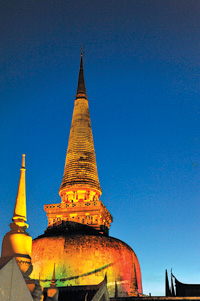 In terms of culture and heritage, southern Thailand is a culture enthusiast’s dream come true. On a Tourism Authority Thailand (TAT) supported trip to Nakhon, the team visited the historical site of Sivijaya, also known as Moklan. 15 km away from the city, the site was the residence of a Moklan prince from Sri Lanka who did not get the throne after his father. The name of the place itself, Nakhon Sri Thammarat, derives from Sri Thammarat Ashoka, who was the last ruler of Moklan. The word Sri comes from Sri Lanka while Thammarat means teachings. Diminutive as it may appear, Srivijaya stands as a good example of the kind of culture and cultural influences that is apparent in much of Nakhon. Besides displaying strong ancient cultural ties with neighboring countries, it also shows how the interconnected nature of locals and local practices with these sites highlighted the presence of colorful caityas that stand over burial spots for ashes of the deceased.
In terms of culture and heritage, southern Thailand is a culture enthusiast’s dream come true. On a Tourism Authority Thailand (TAT) supported trip to Nakhon, the team visited the historical site of Sivijaya, also known as Moklan. 15 km away from the city, the site was the residence of a Moklan prince from Sri Lanka who did not get the throne after his father. The name of the place itself, Nakhon Sri Thammarat, derives from Sri Thammarat Ashoka, who was the last ruler of Moklan. The word Sri comes from Sri Lanka while Thammarat means teachings. Diminutive as it may appear, Srivijaya stands as a good example of the kind of culture and cultural influences that is apparent in much of Nakhon. Besides displaying strong ancient cultural ties with neighboring countries, it also shows how the interconnected nature of locals and local practices with these sites highlighted the presence of colorful caityas that stand over burial spots for ashes of the deceased.
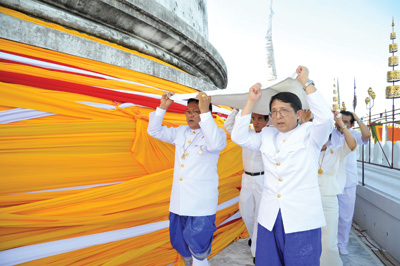 Next on our list was an amazing public display of affection for local culture and traditional rituals, the Magha Puja circumambulation festival. The streets of Nakhon came alive with people from security forces to the general public to school going students, carrying hundreds of meters of Phra Bata cloth – the cloth used by Buddhist monks for their robes. Each displayed and carried different accessories to mark this festival. There were cultural dances on the street, some carried murals depicting the life of the Buddha while some played traditional music on a mandolin plugged into an amplifier. The event was even supported by the international Buddhist community, with representatives from India, Sri Lanka, Vietnam, Laos, Vietnam and Myanmar participating in the festival.
Next on our list was an amazing public display of affection for local culture and traditional rituals, the Magha Puja circumambulation festival. The streets of Nakhon came alive with people from security forces to the general public to school going students, carrying hundreds of meters of Phra Bata cloth – the cloth used by Buddhist monks for their robes. Each displayed and carried different accessories to mark this festival. There were cultural dances on the street, some carried murals depicting the life of the Buddha while some played traditional music on a mandolin plugged into an amplifier. The event was even supported by the international Buddhist community, with representatives from India, Sri Lanka, Vietnam, Laos, Vietnam and Myanmar participating in the festival.
The carnival like environment later congregated at the Phra Mahathat Woramaha Wiharn, which also houses the Phra Borom That Chedi at its center. This stupa like structure is reportedly 600 years older than its surrounding caityas and statues and was given its current Sri Lankan style shape much later in 1227 A.D. It supposedly a tooth of the Buddha and the steps to the center of the stupa are guarded, quite interestingly by Hindu deities. The ceremony coincides with the full-moon day of the 3rd Thai lunar month (usually in late February or early Mar), which is one of the holiest Buddhist holy days.
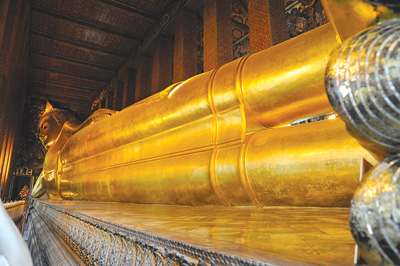 Magha Puja Day marks the occasion when 1,250 saint-disciples of the Buddha spontaneously gathered to hear the Buddha preaching his doctrine, and culminates with a candlelit procession around the local temple’s bot.
Magha Puja Day marks the occasion when 1,250 saint-disciples of the Buddha spontaneously gathered to hear the Buddha preaching his doctrine, and culminates with a candlelit procession around the local temple’s bot.
In the evening, locals and visitors gathered at the temple to hear a sermon by the chief monk of the wat, an occasion attended by chiefs of the local government including the Governor of Nakhon province. A sea of calm spread in front of the temple premises as thousands clasped their hands in prayer, holding candles, flowers and incense and following the chanting monks around the bot of the wat three times.
A demonstration by young artists, including dancers, musicians and singers preceded the Phra Bata cloth parade and the Magha Puja. Staged at one large corner of a local park and bordering on an ancient brick wall that separates the new town from the old, the light and sound extravaganza was something to write home about. Spirited and charged performances, including scenes from the Ramayana pierced the humid night air. Behind us, numerous stalls sold local delicacies as a puppeteer staged an amusing set, mixed with double innuendos that got the locals laughing their heads off. For a foreigner, the mood of the night, together with the spirit of all the Thais who had come together to support their culture was humbling.
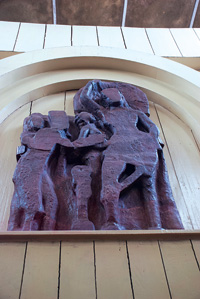 If all this culture however, were to get overwhelming, there are beautiful escapes to make. Take for instance the Racha Kiri Resort and Spa at Khanom, where we checked in for a relaxing night. With luxurious rooms that overlook the ocean, a mouth watering menu offering everything from local to international cuisine, a swimming pool that winds down to a private beach and hospitable staff (that leave behind notes on leaves to say good night), it’s a great value for money resort that immediately loosens you up. Value for money is another thing the Thais have perfected, breaking most myths that correlate comfortable travel to high expenses. Thailand surprises in this regard with a number of great options available for travel, board and food to suit every pocket size.
If all this culture however, were to get overwhelming, there are beautiful escapes to make. Take for instance the Racha Kiri Resort and Spa at Khanom, where we checked in for a relaxing night. With luxurious rooms that overlook the ocean, a mouth watering menu offering everything from local to international cuisine, a swimming pool that winds down to a private beach and hospitable staff (that leave behind notes on leaves to say good night), it’s a great value for money resort that immediately loosens you up. Value for money is another thing the Thais have perfected, breaking most myths that correlate comfortable travel to high expenses. Thailand surprises in this regard with a number of great options available for travel, board and food to suit every pocket size.
Buddhism in Nepal and lessons to learn
Drawing comparisons between Nakhon Sri Thammarat in Thailand and Lumbini in Nepal is easy. Located strategically at the Indo-Nepal border, Lumbini is the birthplace of the Shakya prince Siddhartha Gautam, a fact endorsed by UNESCO which announced it as a UNESCO World Heritage Site in 1997. UN Secretary General U Thant visited the site in 1967 and disheartened at the state of the place, immediately set up the Lumbini Master Plan, which would see countries from all over the world build viharas that represented Buddhism in their countries. The result of that planning is present in Lumbini for all to see, a massive project, led more by faith than ambition, representing how Buddhism spread all over the world from its origins in this tiny, hot town.
Both places are to the south of their countries and development at both sites started comparatively recently. While Nakhom already has great roads, electricity, water supply and star resorts set up, Lumbini too is getting there. Numerous new hotels are coming up in Lumbini, from star resorts to smaller lodges to cater to varying needs and budgets. Lumbini however, still has a long way to go in at least one regard. While Nakhon has packaged and marketed its cultural history well, Lumbini is still only getting there. Still, tourist numbers are up and private companies have shown much interest in marketing and promoting Lumbini as an excellent cultural destination. Also like Nakhon, Lumbini shares a rich history with its southern neighbor India. The Buddhist circuit, a trail that plots the travels of the Buddha from his birth to Nirvana, crosses over to India many a times. Although the Buddha was born in Nepal in Lumbini, it was in Boudhgaya in India that he attained enlightenment.
There are lessons to le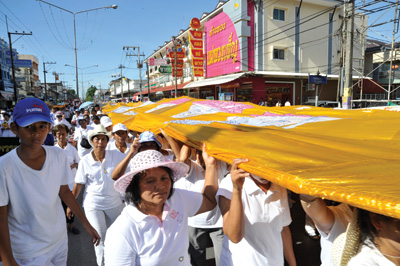 arn from Thailand for travel and tourism entrepreneurs in Nepal. It is impressive how enthusiastic the Thais are regarding not just marketing but also supporting their rich culture. Equally exemplary is the zeal of the youth of the country, who seem to run everything from roadside rich-chicken stalls to five star resorts. The result is that a youthful current runs over, under and through tourism there, something worth studying and learning from, the best way to do which would be to get on a plane and see it for yourself.
arn from Thailand for travel and tourism entrepreneurs in Nepal. It is impressive how enthusiastic the Thais are regarding not just marketing but also supporting their rich culture. Equally exemplary is the zeal of the youth of the country, who seem to run everything from roadside rich-chicken stalls to five star resorts. The result is that a youthful current runs over, under and through tourism there, something worth studying and learning from, the best way to do which would be to get on a plane and see it for yourself.










